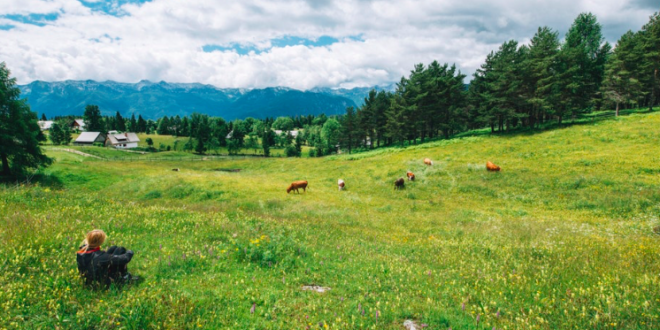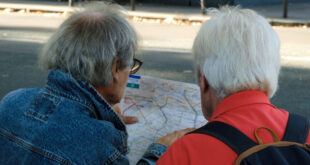There were two of them, and at this time of year my bet was on them being a pair setting up home and getting ready to lay eggs and hatch youngsters within the next few weeks. I sincerely hope so, on several different levels. They were a pair of tui, big, bold, blue-black and each with its nifty white bow-tie.
Three generations of my family – me the oldest, my daughter and my two granddaughters, along with my partner – were paying a visit to the Ohaupo piece of land that had once belonged to my parents.

My early days were on a 150-acre dairy farm in the Otewa Valley, south-east of Otorohanga, and it was there the value of land, the need to look after it, and the skills of not just looking but also seeing and understanding were inculcated into me. Both my parents understood these things, each in entirely different ways. My father was a pragmatic Kiwi, born into farming in the Hawke’s Bay and then on long-time family land on Banks Peninsula. He knew most things about how to utilise land to get the best from it and to give it back the best available. He passed on much of that knowledge to my brother and me.
My mother, a genteel Adelaide woman, would melt in front of a beautiful flower. She would also stand rock-steady in front of a belligerent jersey bull, turning the roaring, blunt-headed, enraged animal by sheer force of character, this tiny woman in her size 4 gumboots planted firmly in the mud and waving an apple pruning no thicker than a finger. She had courage beyond belief.
She understood plants, especially flowers, better than anyone I’ve ever met. She also understood people with remarkable ability, and was placid in the face of great agitation. But if she detected injustice in any form, especially if it was directed towards the underprivileged, her brief, pungent comment would slice into the heart of the injustice and leave the perpetrators totally eviscerated. She taught us to be aware of our surroundings, and to observe the small things that add up to big things.
And in 1965 my parents sold the Otewa property – two sons had interests elsewhere, and Dad had always said he would sell the farm when his dog died or when he turned 50, whichever happened soonest. Raid, his beloved dog, died when he was 50, and he sold the farm.
Subsequently he bought 40 acres just south of Ohaupo, and set about transforming it from a run-down slab of grubby, overgrown ground into a place of beauty. From time to time my brother and I helped him, and there were several huge bonfires of accumulated blackberry, gorse, hawthorn, barberry, lawsoniana, and assorted dead trees. He built fences, put in water troughs, cleaned out weeds, fixed sagging sheds. Within a few years he and my mother designed and had built a beautiful new home further back off the road, overlooking Lake Rotomanuka, and it became their dream-home.
My father, a tree-planter since his early days on the Otewa farm, planted trees, scores of them. He mixed natives with exotics, picture trees with shade trees, trees that would grow huge over the next 500 years, and some that had use-by dates of half a century. In the extensive gardens around the house my mother planted flowers and shrubs and herbs and succulents and bulbs to her heart’s content. There was a massive daphne bush just off the terrace overlooking the lake, where she emptied the tea-pot after she and my father had sat contentedly over scones and hot cuppas for morning tea most mornings. The superb smell of that daphne when it was in flower wafted through much of the house.
There was a massive ancient magnolia tree near the ‘old house’, and it was there that a lone kereru – native pigeon – visited twice a year, once on his way from Maungatautari to Pirongia, and again on the return journey. In the early years, between 1965 and 1970, a single kotuku – white heron – arrived on the lake too at sort of regular intervals, when he was heading north to places unknown, and months later when he was heading south, probably back to Okarito in the South Island.
Sadly, ‘progress’ elsewhere in the world put paid to their visits, and we were all the poorer.
So, recently three generations – son, granddaughter, two great-granddaughters, and a partner – visited that piece of land for a voyage of remembrance. It was August 11, my mother’s birthday, and had she been alive she would have been 98 that day. She died in February, after being delighted the previous August to celebrate being 97.
We took flowers, placed them on the graves in the old Ohaupo cemetery, and spent a little time in reflection.
The present owners of the land – they bought it from my parents I believe in the mid-1980s – were most gracious in allowing us to wander at will across the property, and our host Lee, who has an interest in the history of the area, happily came with us. She told us of the changes and improvements and alterations they had made.
Daughter Karen, who lived on the property when she was a child, and I were both astounded at how ‘small’ it all was now, especially the ancient hay shed and the paddocks. Karen talked of building tunnels and cubby-holes in amongst the hay-bales, oblivious of the dangers of cave-ins. My brother and I did exactly the same a generation earlier when we were kids on the Otewa farm.
She talked too of the Mutley-Hut, actually a killing shed where meat carcasses were once hung overnight to cool, but later the preserve of my daughter’s older cousins from Hamilton who stored a large carton of Mickey Mouse and Donald Duck comics there. Even though the cousins were miles away, the young girl would regularly sneak over to the hut, terrified of being discovered, and nick a half-dozen comics, to be read by torch-light under the blankets in case the cousins unexpectedly turned up at that hour of the night.
And there were the several groves of trees and numerous individual specimens my father had planted. Some of them have grown to maturity, several are beginning to collapse from old age, and others, especially the natives, are just starting to reach early adulthood. The land has been subdivided, and there were several areas we couldn’t visit because someone else owned them, but we could see strong and vigorous kauri, totara, rimu, and others towering 20 metres and more into the sky.
There is one area, always known as The Bush Glade and set in the head of a wet gully, which my father had been especially proud of. It is roughly 50 metres square, and in it he planted kauri, kahikatea, rimu, totara, puriri (just now in brilliant crimson flower), tanekaha, miro, lemonwood, and punching its gutsy little way up through the wandering jew ground-cover Lee spied a tiny titoki. I silently wished him kia kaha on his journey to the light over the next century, and I firmly believe he’ll make it too.
There are now second generation self-planted kahikatea in The Bush Glade, and what is even better is that this is where the big, sturdy pair of tui have established themselves. They were not to be frightened out of their territory by a few nosy humans, and they sat boldly in the branches overhead, chortling and chucking and hollering as we mooched about below. A little piwakawaka – fantail – also danced about above our heads, chittering excitedly as he did.
As we walked back across the paddocks to the car, another robust tui came flashing across the sky, probably from the native trees along the lake-edge, heading obviously for The Bush Glade.
Yes, well … at this time of year two’s company; three’s a crowd. He may not have been welcome in that little microcosm. But Mother Nature handles such events with the usual iron fist in a velvet glove. The outcome is hers to decide, and whatever it is will be best in the long run.
In any event, Meg and Roly, parents, grandparents and great-grandparents to us visitors, would have been absolutely delighted to know that their plantings of half a century ago have resulted in the reintroduction of such high-profile native birds into the area.
That, I reckon, is true conservation.
Read more from Kingsley Field here
Kingsley Field writes a fortnightly Outdoors column in the Waikato Times, and has published two illustrated volumes of his columns. He can be contacted at kingsley(at)accuwrite.co.nz









Join the Discussion
Type out your comment here:
You must be logged in to post a comment.